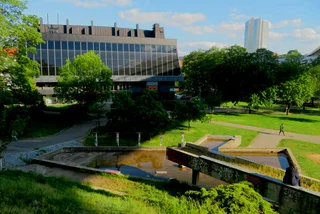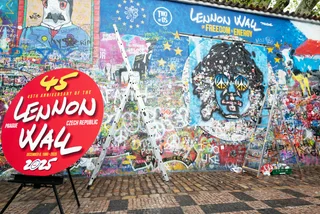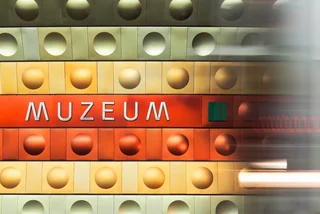Half a century ago, it became much easier for people to get from one side of Prague to the other. The Nusle Bridge opened to traffic on Feb. 22, 1973.
Mayor Bohuslav Svoboda and Deputy Mayor Zdeněk Hřib marked the anniversary with a ride on a historical train from the 1970s on the C line from Kaceřov through the bridge to Muzeum and back.
Svoboda, who was in his late 20s when the bridge was built, said it was an important accomplishment for his generation. “I consider the look of the bridge to be timeless. … The construction and technical aspects were innovative in many respects and at the time there was no parallel in the world,” Svoboda said, adding that the bridge confirmed the “quality of Czech heads and hands.”

The trip from Pankrác to I.P. Pavlova was shortened by at least 20 minutes. Svoboda, who worked as a medical doctor, pointed out that the bridge made it much easier for people in the southeast of Prague to reach the General University Hospital (VFN) located on the other side, for example.
Deputy Mayor Zdeněk Hřib, responsible for transportation issues, said the bridge won an architectural award for the “building of the century” in 2000. “Even a modern transport structure can be a valuable architectural monument and at the same time a fantastic technical work,” he said.

The bridge was renovated 10 years ago and is now in excellent technical condition. But that can’t be said about all of Prague’s bridges. Hřib, who just ended a five-year term as mayor, said that in his new role as deputy mayor for transportation he plans to keep the current renovations and repairs of the city’s bridges as planned and that more bridges are currently being evaluated for potential renovations. He confirmed, though, that the city doesn’t own the railway bridge at Výtoň and has very little say in whether it will be preserved.


The Nusle Bridge (Nuselský most) was built from pre-stressed concrete, and it has a length of 485 meters. Aside from a tunnel for metro train traffic, it also has six lanes for car traffic and two pedestrian walkways.
The idea to build a bridge across the Nusle Valley was first put forward in 1903, and there were even architectural contests for designs. The last contest was held in 1959–61, and this created basic design.



Nusle Bridge in numbers:
- Length: 485 meters
- Width: 26.5 meters
- Weight: 65,800 tons
- Opening: Feb. 22, 1973
- Metro start: May 9, 1974
- City registration number: X676
Work began in 1965 with the demolition of 14 apartment buildings located on land that would be needed for the bridge supports. Originally, the bridge was supposed to carry trams, and changes to the design had to be made once the much heavier metro was planned instead.
Main work on the bridge surface was already finished by November 1970, and to test the strength of the bridge 66 Soviet T55 tanks were parked on the surface.



When the bridge opened on Feb. 22, 1973, traffic was limited because the connecting highway section was not completed. Full service for cars began on April 30. Train service didn’t begin until May 9, 1974.


Originally, it was called the Klement Gottwald Bridge (Most Klementa Gottwalda) after the communist leader from the early 1950s. The metro stop just before the bridge at Vyšehrad used to be called Gottwaldova until the Velvet Revolution.
The bridge had another informal name as well – the suicide bridge. Over the years, up to 400 people may have used the bridge for this purpose. High railings were installed after 1990 to prevent this use. Artist Krištof Kintera made a memorial to the victims, a street lamp pointed upward, in 2011.












 Reading time: 3 minutes
Reading time: 3 minutes 

































